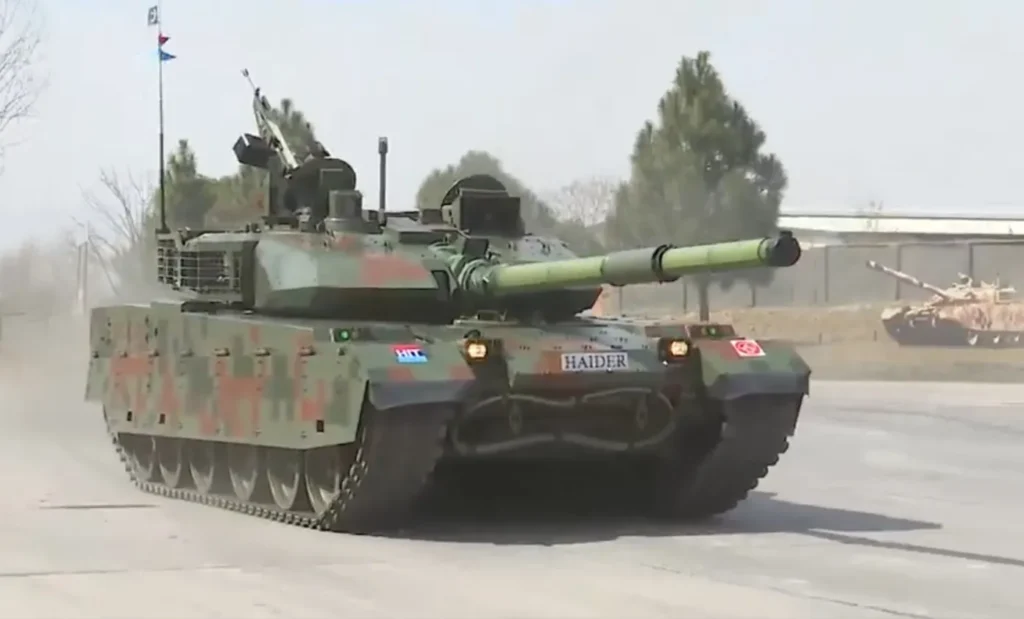
Brig ® Atif Shafique
The Heavy Industries Taxila (HIT) of Pakistan recently celebrated the commencement of the first serial production of the Haider Main Battle Tank. The event, graced by the presence of General Asim Munir, the Chief of Staff of the Pakistan Army, featured the introduction of the Haider MBT. This tank, a product of indigenous development, is a third-generation vehicle based on the technology of the Chinese VT4.
The Haider is armed with a powerful 125mm Smoothbore gun, which is capable of utilizing a variety of ammunition types, including the Armor Piercing Fin-Stabilized Discarding Sabot (APFSDS) and Anti-Tank Guided Missiles (ATGMs). It incorporates a sophisticated fire control system that merges numerous sensors and targeting mechanisms to enhance both precision and destructive power in combat scenarios.
Equipped with a turbocharged, electronically-controlled diesel engine that delivers 1,200 horsepower and is paired with a hydro-mechanical automatic transmission, the Haider showcases remarkable agility. It boasts a top speed of 70 km/h on roads and a substantial operational range of 500 km.
The introduction of the Haider Main Battle Tank marks a pivotal advancement in Pakistan’s defense capabilities, underscoring the country’s dedication to achieving self-sufficiency in its military needs. It is a 3rd Generation Plus Tank which has been manufactured through collaboration with NORINCO China and various local industries of Pakistan. The Tank incorporates modern state of the art technologies and astounding capabilities which gives it a definitive edge over any adversary in the battle field. Distinguished features that make Tank Haider a more lethal and potent war machine as compared to other Tanks are:-*
*a. High maneuverability due to optimized power to weight ratio, high performance 1200 hp engine with automatic transmission and digital navigation in all types of terrains and* *environment*.
*b. Greater lethality with long-range precision engagement, high first round hit probability and hunter killer capability achieved through latest generation of optical sights and Thermal Imager based auto-tracking with improved image stabilised fire control systems (FCS) and gun control systems (GCS).*
*c. Greater adaptability through digitized architecture providing plug and play modularity for various systems, enhanced sensor based real time battlefield situational awareness, requisite connectivity for seamless Combine Arms Operations and secured information sharing resulting in a more potent and reliable platform*.
*d. Improved survivability through low heat signature, advanced Explosive Reactive Armour along with passive and active protection systems and modern systems for crew survivability from fire, explosives and Nuclear, Biological and Chemical threats.*
*e. Enhanced reliability through adaptation of latest manufacturing techniques, engineering practices and quality control mechanism*.
*f. Cost effectiveness due to maximized local* *manufacturing of parts, assemblies and systems ensuring assured self-sustenance*.
*- Tank Haider is a true manifestation of “Strength through Self Reliance” in defence production of Pakistan due to maximized* *indigenization, resulting in substantial foreign exchange savings while empowering our local industries through selective technology partnerships for in-country manufacturing.
Some of the top tanks, commonly recognized for their advanced capabilities include the M1 Abrams (USA), Leopard 2 (Germany), Challenger 2 (UK), T-14 Armata (Russia), and the Merkava Mark IV (Israel). To compare them with Pakistan’s Haider MBT, let’s examine a few key aspects:
Firepower
- M1 Abrams, Leopard 2, Challenger 2, T-14 Armata, and Merkava IV are equipped with powerful main guns (120mm for Abrams, Leopard, and Challenger; 125mm for T-14 Armata and Merkava IV) capable of firing a range of advanced munitions. These tanks also feature sophisticated fire control systems to enhance accuracy and lethality.
- Haider MBT boasts a 125mm Smoothbore gun similar to the T-14 Armata and Merkava IV, with the capability to fire various ammunition types, including APFSDS and ATGMs. Its advanced fire control system is designed to improve accuracy and effectiveness in combat, aligning it with the standards of modern MBTs.
Protection
- Top MBTs like the M1 Abrams and Leopard 2 have composite armor augmented with active protection systems (APS) to defend against anti-tank guided missiles and RPGs. The T-14 Armata is notable for its next-generation armor protection and the use of an unmanned turret to enhance crew safety.
- Haider MBT‘s specific armor composition details are not publicly disclosed, but it is expected to incorporate composite armor and possibly active or passive protection systems to meet contemporary battlefield threats, as is standard for modern MBTs.
Mobility
- Western and Russian MBTs typically feature powerful engines (ranging from 1,500 hp for the M1 Abrams to about 1,200 hp for the T-14 Armata) and advanced suspension systems, enabling high speeds and strong cross-country performances.
- Haider MBT is powered by a turbocharged electronically-controlled diesel engine generating 1,200 hp, comparable to the T-14 Armata, offering a maximum road speed of 70 km/h and a cruising range of 500 km. This suggests that the Haider is designed to match the mobility standards of its international counterparts.
Technological Advancements
- Global MBTs incorporate the latest in military technology, including network-centric warfare capabilities, advanced sensors, and remotely operated weapon stations.
- Haider MBT integrates an advanced fire control system with a suite of sensors and targeting devices, indicating a focus on leveraging technology to enhance battlefield performance. Details on network-centric capabilities or additional technological features are less known.
- Comparison with Indian Tanks When compared to India’s Arjun and T-90S Bhishma, the Haider seems to offer comparable firepower and technological capabilities. The Arjun has more engine power (1400 hp as compared to 1200 hp of Haider, while the T-90S has the same engine power as of Haider. Each tank reflects the strategic preferences and technological access of its country. Factors such as terrain adaptability, crew training, and logistical support play crucial roles in determining the effectiveness of these tanks in actual combat scenarios. Obviously both will have to lock the horns in the same terrain.
Conclusion
Haider MBT represents a significant advancement in Pakistan’s defense manufacturing capabilities and appears to align with global standards in several key areas. Its direct comparisons with some of the world’s best MBTs, mentioned above, should consider factors such as operational history, combat-proven performance, and the integration of cutting-edge technologies. Each of these tanks has been developed with the specific strategic needs of their respective countries in mind, influencing their design and capabilities.
The author is a defence analyst. He heads the War Strategy Div of the School of Strategic Studies.


